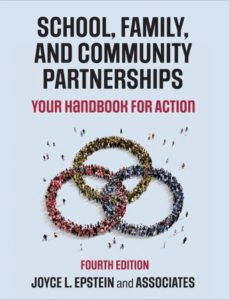Joyce L. Epstein, Ph.D. Director, NNPS
School buildings are closed, but “school” and learning are open. The geography of school has expanded across neighborhoods into students’ homes and onto kitchen tables. The swift change in policy to children learning at home is generating many ideas by educators and community organizations. Some interpret the demand for lessons only in terms of high-tech options, such as online or Zoom classes. This may work at the college level, but for K-12 students, educators must consider—from the outset—the dramatic digital divide that affects families and students in all communities across the country. As we consider how to conquer the COVID-19 crisis, we must think-new about how to conduct effective and equitable outreach to guide families in supporting their children’s learning when school buildings are closed.
Research on Summer Learning
We can learn about the need for well-planned activities to help students keep learning when school buildings are closed from research on the effects of summer learning. Studies show that students at different skill levels make about one year of progress from their starting points in one year’s time. However, during the summer, students from families with low incomes tend to lose an average of two months of reading/literacy skills. They require remedial work at the start of the new school year, which delays their progress in learning at each grade level. By contrast, during the summer, students from families who are economically advantaged tend to maintain or gain skills by reading books and conducting other literacy-linked activities (See references in NNPS Sampler: Summer Learning Not Summer Loss.) Studies also show that when students conduct learning activities during the summer, they reduce learning loss, gain confidence, and increase motivation to learn, regardless of family income level.
Practical Approaches—Focus on Equity with Different Technologies
Educators must know their families’ available technologies and their students’ strengths and needs to develop and disseminate feasible and useful lessons, projects, and activities for students. Assigned learning activities must match the subject- and grade level-goals for teachers’ own students. In this way, students have the best chance of maintaining and advancing school skills.
High Tech—Online Learning Lessons and Resources
Teachers may use high-tech platforms to communicate with families (e.g., e-mail, Facebook, REMIND, parent portal, school/classroom website), and to disseminate information and activities for students. Online (e.g., Zoom) classes can be effective for some students with access to platforms for distance learning. Teachers must clarify for parents the 2-way channels of communications from school-to-home and home-to-school for parents and students to ask questions and obtain guidance on lessons and activities.
Teachers, principals, and district leaders need to review high-tech resources to find grade-specific and skill-specific websites that are easy for students to use at home, and easy for parents to see students’ work and progress. Some websites build in gamification to make learning fun. Then, teachers can make useful assignments to help their own students keep learning and limit learning loss. A few proven sites that offer subject- and grade-specific learning opportunities include:
- Education.com for PreK-5, subject specific skills in math and
language arts.
- Education World for teachers to explore for projects activities
that match their curricula and planned units of work.
- PTO Today for ideas for family craft and game activities.
- Colorín Colorado on School Responses to
COVID-19: ELL/Immigrant Considerations
Low Tech—Learning by Doing: Once and today, pencils, pens, crayons, and markers were “high-tech” and in great demand. These remain available and useful learning tools. Teachers may plan and deliver activities and guide parents to help students maintain and strengthen grade-level reading, writing, math, science, and other skills and talents using low-tech materials. Students do not need computers to conduct the following:
- Read stories, poems, non-fiction books
- Create graphic stories
- Write stories, poems, and raps and read them aloud to a parent or family partner
- Draw and sketch people, places, and things to create an art portfolio
- Create a cartoon character and related stories
- Conduct oral history reports or interviews with parents, grandparents, siblings, friends, neighbors on topics of importance by grade level
- Take photos and create thematic albums
- Critique TV shows
- Compile a favorite foods and recipe book
- Conduct other creative hands-on activities in math, science, and other subjects
Adaptable-Tech: Project Learning
Teachers may approve long-term projects in different subjects for high school students and short-term projects for students in the middle grades and upper elementary grades. Projects are challenging and fun for students to conduct and complete, and can link to and build on classroom units of work. Students will use their available technologies—high tech or low tech—for their projects.
Needed Communications
Check in: Teachers should guide students and families to set a routine at home for time to keep learning, along with time for fun and play. This includes explaining how teachers will use high-tech and low-tech strategies to “check in” with students and families to address questions and to record students’ progress.
Collect students’ work: Students respond to options for extra credit. They must collect their work, record a log of hours of reading, obtain parents’ signatures and/or comments, and submit their work when school opens again.
Engage parents with students: Teachers assignments to students should include ideas for parents to have positive conversations with their children about their ideas and activities. These guided interactions may be shared in the language of the family and draw on the knowledge parents have about how school skills are used in every day life.
Make sure about meals: Districts and schools must see that all students who received breakfast and lunch at school know where, when, and how these meals will be available via Grab and Go, pick-up locations, community sites, or home delivery.
It is imperative to reduce or eliminate serious inequalities for student learning that will result in increasing achievement gaps. The goal for action is to spread benefits of learning activities at home to keep more students—all students—on the path to success in school.
Policy Implications
Education policy leaders and educators must fulfill two major requirements for learning-at-home opportunities for students at all grade levels.
1. Focus on equity. Plans, activities, and resources must be available and important for all students, including those who have easy and reliable access to high-technology platforms and those who do not. There is a documented digital divide among families in affluent and economically-stressed communities, and in urban, suburban, and remote rural locations.
2. Educators’ responsibility. Teachers, teacher grade-level teams, district curricular directors, and other education leader must take the lead in producing and disseminating grade-specific and subject-specific activities for their own students. Every family has many skills and talents to share with their children. However, it is not up to every parent in America to figure out how to develop and assign activities to ensure that their children keep learning important school skills at each grade level.
The immediate response to COVID-19 was to close schools and send students home, which left millions of students and families on their own to think about making time for learning. Now, for the next few weeks or longer, teachers who are, themselves, working from home, must develop and disseminate clear and useful lessons, projects, and creative activities that will meet their own students’ needs and skill levels. Teachers’ work and connections with parents and students need to advance student learning.
At the National Network of Partnership Schools (NNPS) at Johns Hopkins University, we are working with over 500 schools and more than 50 districts, organization, and state offices of education to address the partnership challenges of COVID-19. The goal is for all teachers to enable all families to support their children’s learning using their available and reliable technologies.
At this time, there are no studies of the results of different designs for student learning linked to the COVID-19 crisis. Interestingly, the immediate demand to enable families to guide students’ learning at home opens valuable natural experiments for researchers to study to examine the responses of families and results for students of the various high-tech and low-tech strategies used in diverse communities.
Reflection
These are tumultuous times. COVID-19 created unwanted, but important, opportunities to develop resources and strategies for student learning at home. The products and processes can be used now—when school buildings are closed—and may also be useful at other times such as during storm closings and summer vacations. The need to address the COVID-19 crisis will bring important new attention to the shared responsibilities—the partnerships—of teachers and parents to ensure equal opportunities for students to keep learning.
Video Interviews
The Johns Hopkins University School of Education’s Center for Safe and Healthy Schools interviewed several professors on the implications of COVID-19 on student learning, school improvement, family engagement, and more. Dr. Joyce Epstein, Director, NNPS is one of the speakers on school and family partnerships at the time of the COVID-19 crisis. See short videos at: https://education.jhu.edu/cshs/academics/interview-series/
Blog with NNPS.
What do you think?
- What has your district, school, organization, or state done to help teachers plan communications with families and students and activities to help students keep learning?
- How have teachers in your location taken into account the high-tech and low-tech resources in their students’ homes?
- What was most useful to you in the NNPS Blog on COVID-19 and students’ opportunities to learn?
Send your info to Rachel Chappell, nnps@jhu.edu to share on NNPS Facebook and Twitter sites.

